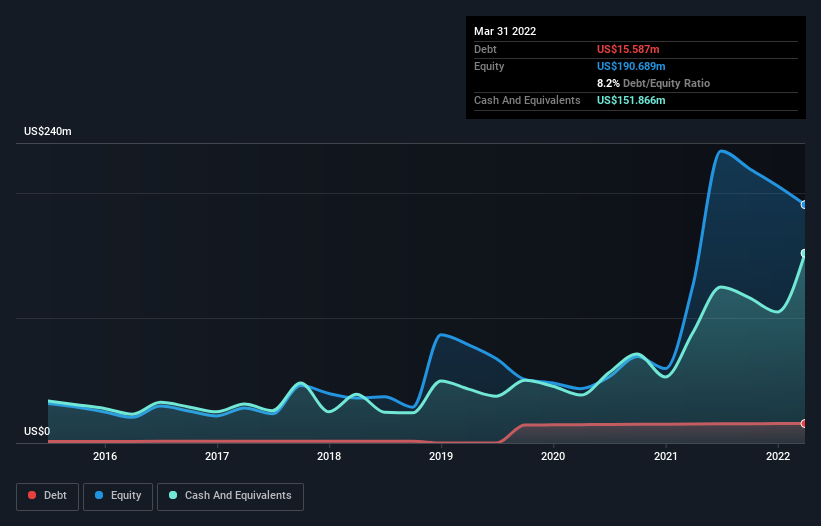Is Aldeyra Therapeutics (NASDAQ:ALDX) Using Debt In A Risky Way?
Legendary fund manager Li Lu (who Charlie Munger backed) once said, 'The biggest investment risk is not the volatility of prices, but whether you will suffer a permanent loss of capital.' It's only natural to consider a company's balance sheet when you examine how risky it is, since debt is often involved when a business collapses. We can see that Aldeyra Therapeutics, Inc. (NASDAQ:ALDX) does use debt in its business. But the more important question is: how much risk is that debt creating?
What Risk Does Debt Bring?
Generally speaking, debt only becomes a real problem when a company can't easily pay it off, either by raising capital or with its own cash flow. If things get really bad, the lenders can take control of the business. While that is not too common, we often do see indebted companies permanently diluting shareholders because lenders force them to raise capital at a distressed price. Having said that, the most common situation is where a company manages its debt reasonably well - and to its own advantage. The first thing to do when considering how much debt a business uses is to look at its cash and debt together.
View our latest analysis for Aldeyra Therapeutics
What Is Aldeyra Therapeutics's Net Debt?
The chart below, which you can click on for greater detail, shows that Aldeyra Therapeutics had US$15.6m in debt in March 2022; about the same as the year before. But it also has US$151.9m in cash to offset that, meaning it has US$136.3m net cash.
A Look At Aldeyra Therapeutics' Liabilities
Zooming in on the latest balance sheet data, we can see that Aldeyra Therapeutics had liabilities of US$16.4m due within 12 months and liabilities of US$15.6m due beyond that. On the other hand, it had cash of US$151.9m and US$65.0m worth of receivables due within a year. So it can boast US$184.9m more liquid assets than total liabilities.
This excess liquidity is a great indication that Aldeyra Therapeutics' balance sheet is almost as strong as Fort Knox. With this in mind one could posit that its balance sheet means the company is able to handle some adversity. Simply put, the fact that Aldeyra Therapeutics has more cash than debt is arguably a good indication that it can manage its debt safely. When analysing debt levels, the balance sheet is the obvious place to start. But ultimately the future profitability of the business will decide if Aldeyra Therapeutics can strengthen its balance sheet over time. So if you're focused on the future you can check out this free report showing analyst profit forecasts.
Given its lack of meaningful operating revenue, Aldeyra Therapeutics shareholders no doubt hope it can fund itself until it has a profitable product.
So How Risky Is Aldeyra Therapeutics?
Statistically speaking companies that lose money are riskier than those that make money. And the fact is that over the last twelve months Aldeyra Therapeutics lost money at the earnings before interest and tax (EBIT) line. And over the same period it saw negative free cash outflow of US$42m and booked a US$63m accounting loss. Given it only has net cash of US$136.3m, the company may need to raise more capital if it doesn't reach break-even soon. Overall, its balance sheet doesn't seem overly risky, at the moment, but we're always cautious until we see the positive free cash flow. There's no doubt that we learn most about debt from the balance sheet. But ultimately, every company can contain risks that exist outside of the balance sheet. For instance, we've identified 3 warning signs for Aldeyra Therapeutics (1 makes us a bit uncomfortable) you should be aware of.
If, after all that, you're more interested in a fast growing company with a rock-solid balance sheet, then check out our list of net cash growth stocks without delay.
Have feedback on this article? Concerned about the content? Get in touch with us directly. Alternatively, email editorial-team (at) simplywallst.com.
This article by Simply Wall St is general in nature. We provide commentary based on historical data and analyst forecasts only using an unbiased methodology and our articles are not intended to be financial advice. It does not constitute a recommendation to buy or sell any stock, and does not take account of your objectives, or your financial situation. We aim to bring you long-term focused analysis driven by fundamental data. Note that our analysis may not factor in the latest price-sensitive company announcements or qualitative material. Simply Wall St has no position in any stocks mentioned.

 Yahoo Finance
Yahoo Finance 
